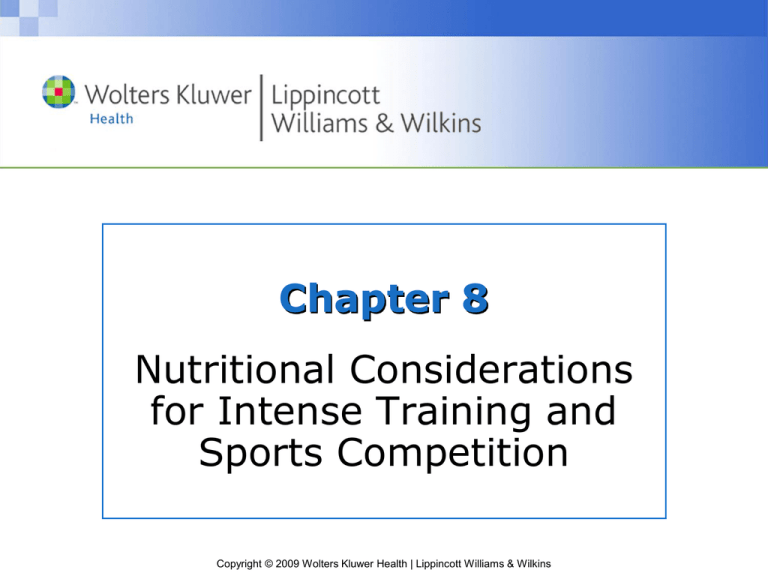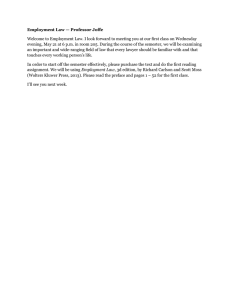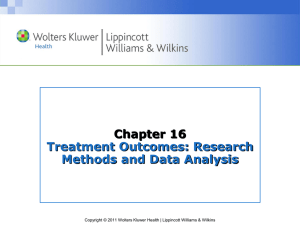Chapter 8 Nutritional Considerations for Intense Training and Sports Competition
advertisement

Chapter 8 Nutritional Considerations for Intense Training and Sports Competition Copyright © 2009 Wolters Kluwer Health | Lippincott Williams & Wilkins The Precompetition Meal Readily digestible foods Should contribute to energy and fluid requirements Meals high in carbohydrates and relatively low in lipids and proteins Three to four hours to digest and absorb the precompetition meal Copyright © 2009 Wolters Kluwer Health | Lippincott Williams & Wilkins Copyright © 2009 Wolters Kluwer Health | Lippincott Williams & Wilkins Ideal Precompetition Meal The ideal precompetition meal: • Contains 150 to 300 grams of carbohydrates • Is consumed 3 to 4 hours before the event • Contains little fat • Contains little fiber Copyright © 2009 Wolters Kluwer Health | Lippincott Williams & Wilkins Liquid Meals High carbohydrate content Supply fluids Digest rapidly Can be used for day-long events Supplement calorie intake in those with difficulty maintaining body weight Copyright © 2009 Wolters Kluwer Health | Lippincott Williams & Wilkins Nutrition Bars High protein content Approximately 25 g of carbohydrate Often include vitamins and minerals May contain dietary supplements Should not substitute for normal food intake Copyright © 2009 Wolters Kluwer Health | Lippincott Williams & Wilkins Nutrition Powders and Drinks High protein content Contain vitamins, minerals, and other dietary supplements Come in powdered form or premixed Contain fewer calories per serving than nutrition bars Copyright © 2009 Wolters Kluwer Health | Lippincott Williams & Wilkins Carbohydrates before Exercise If simple sugars are consumed, they should be consumed at least 60 minutes before exercising. • This time gives hormones the chance to rebalance. Fructose absorbs more slowly compared to glucose or sucrose. • High-fructose beverages can produce significant gastrointestinal distress. Copyright © 2009 Wolters Kluwer Health | Lippincott Williams & Wilkins Carbohydrates during Exercise Allows for a greater intensity during prolonged activities Consuming about 60 g of liquid or solid carbohydrates each hour benefits: • High-intensity, long-duration aerobic exercise • Repetitive short bouts of near-maximal effort Spares muscle glycogen Helps maintain a more optimal blood glucose level Copyright © 2009 Wolters Kluwer Health | Lippincott Williams & Wilkins Copyright © 2009 Wolters Kluwer Health | Lippincott Williams & Wilkins Carbohydrates after Exercise High-glycemic carbohydrate-rich foods Either a single large meal or small frequent meals will replenish glycogen stores. Should be consumed as soon as possible after the activity Avoid legumes, fructose, and milk products. Copyright © 2009 Wolters Kluwer Health | Lippincott Williams & Wilkins Copyright © 2009 Wolters Kluwer Health | Lippincott Williams & Wilkins Glycemic Index Indicates how a carbohydrate-containing food affects blood glucose levels High-glycemic index Moderate-glycemic index Low-glycemic index Affected by food preparation, ripeness, and how foods are combined Copyright © 2009 Wolters Kluwer Health | Lippincott Williams & Wilkins Copyright © 2009 Wolters Kluwer Health | Lippincott Williams & Wilkins Copyright © 2009 Wolters Kluwer Health | Lippincott Williams & Wilkins Glycogen Depletion High-intensity aerobic exercise for 1 hour decreases liver glycogen by about 55%. A 2-hour strenuous workout nearly depletes the glycogen content of the liver and specifically exercised muscles. Copyright © 2009 Wolters Kluwer Health | Lippincott Williams & Wilkins Hydration Solutions Carbohydrate-containing solutions consumed during exercise enhance endurance performance by maintaining blood sugar concentration. Glucose supplied in the blood can: • Spare existing glycogen in active muscles • Serve as “reserve” blood glucose for later use should muscle glycogen become depleted Copyright © 2009 Wolters Kluwer Health | Lippincott Williams & Wilkins Copyright © 2009 Wolters Kluwer Health | Lippincott Williams & Wilkins Oral Rehydration Solutions Provide additional glucose Minimize the effects of dehydration on: • Cardiovascular dynamics • Temperature regulation • Exercise performance Adding electrolytes aids in: • Maintaining thirst mechanism • Reducing the risk of hyponatremia Copyright © 2009 Wolters Kluwer Health | Lippincott Williams & Wilkins Carbohydrate-Electrolyte Beverages The ideal hydration solution contains between 5% and 8% carbohydrates. This permits carbohydrate replenishment without adversely affecting fluid balance and thermoregulation. Maintains glucose metabolism and preserves glycogen during prolonged exercise Copyright © 2009 Wolters Kluwer Health | Lippincott Williams & Wilkins Hydration during Exercise Adding moderate amounts of sodium to the ingested fluid helps to maintain plasma sodium concentration. This benefits the ultra-endurance athlete at risk for hyponatremia. Maintaining plasma osmolality with added sodium in the hydration beverage reduces urine output and sustains the sodium-dependent osmotic drive to drink. Copyright © 2009 Wolters Kluwer Health | Lippincott Williams & Wilkins Copyright © 2009 Wolters Kluwer Health | Lippincott Williams & Wilkins High-Fat Diets Conflicting research findings Detrimental health risks are possible. Heath risks may not apply to athletes. Significant restrictions in fat impair exercise endurance. Copyright © 2009 Wolters Kluwer Health | Lippincott Williams & Wilkins






